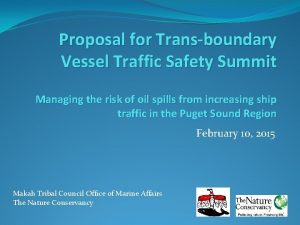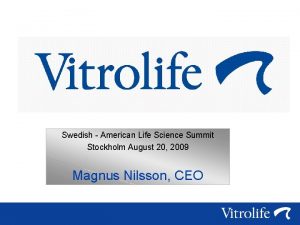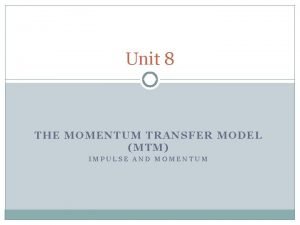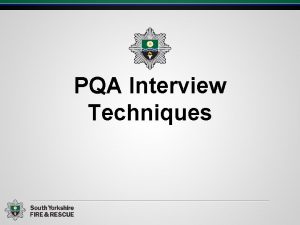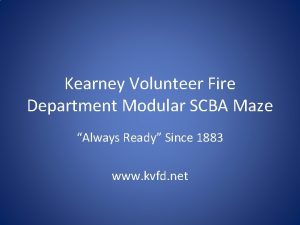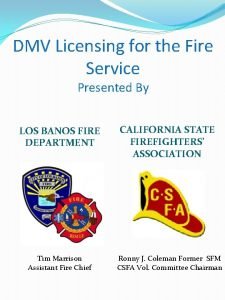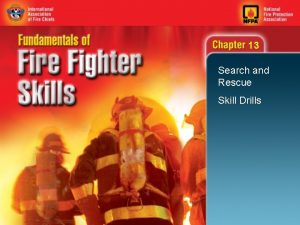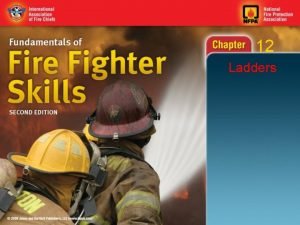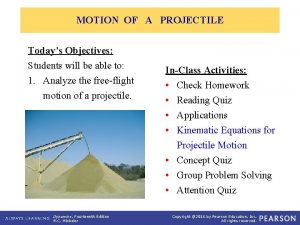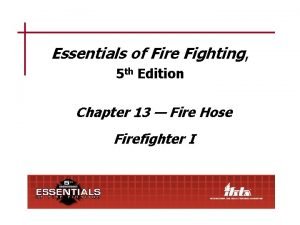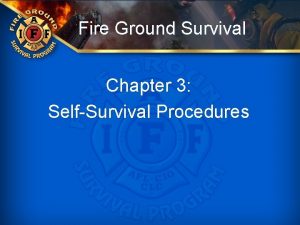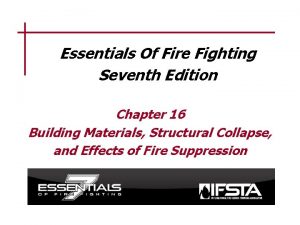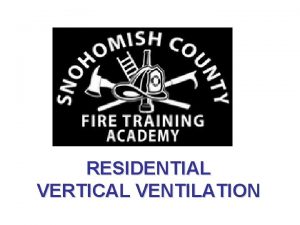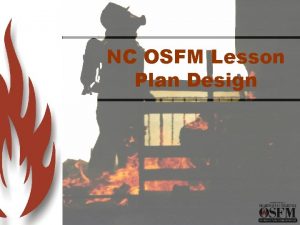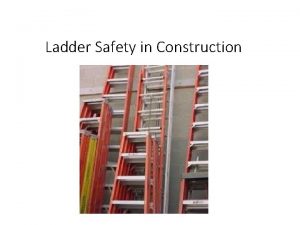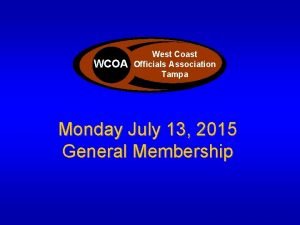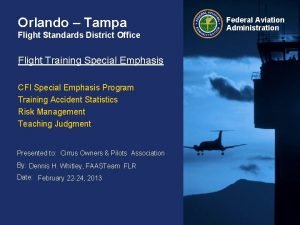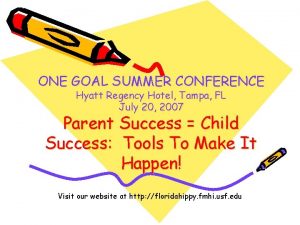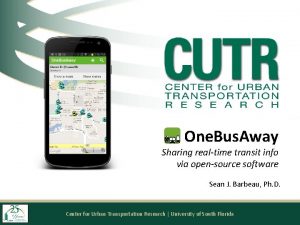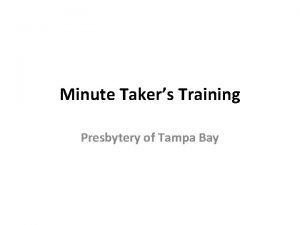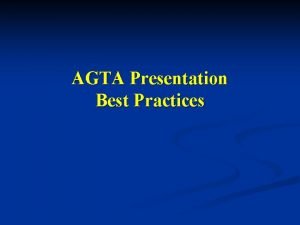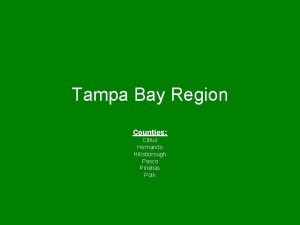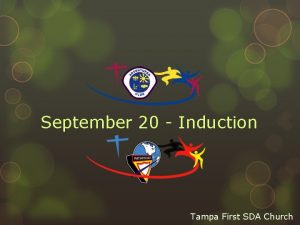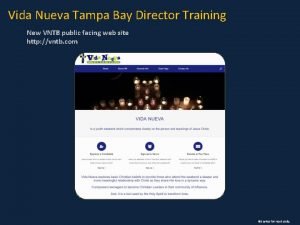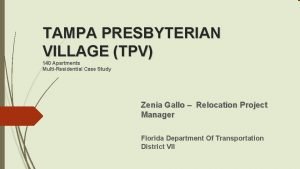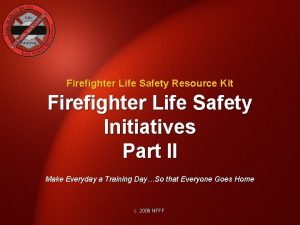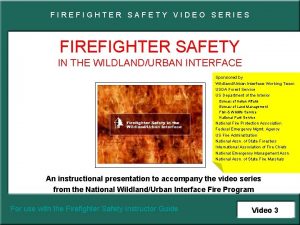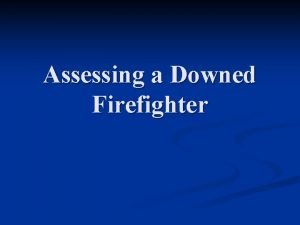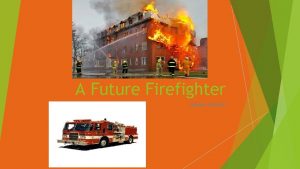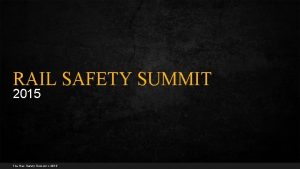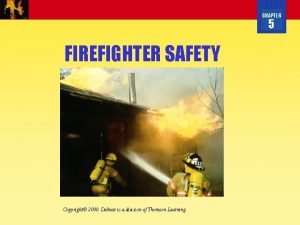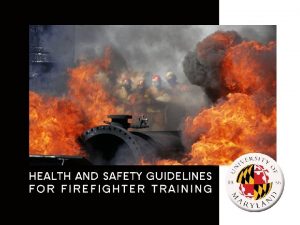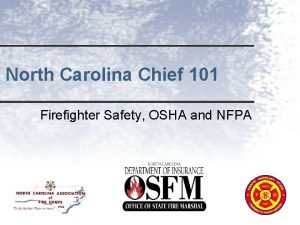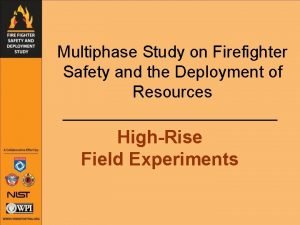The Second Firefighter Life Safety Summit TAMPA 2








































- Slides: 40


The Second Firefighter Life Safety Summit: TAMPA 2 Chief Ronald J. Siarnicki Metropolitan Fire Chiefs June 4, 2014

Everyone Goes ® Home In 2004, the NFFF expanded its mission to include the prevention of firefighter injuries and line-ofduty deaths through the Everyone Goes Home® program and the 16 Firefighter Life Safety Initiatives.

1 st National Firefighter Life Safety Summit Tampa - March 2004 Objective: Produce a consensus agenda among the leading fire service organizations to reduce LODDs 248 participants from the United States and Canada.

What are the 16 Initiatives? 5

16 Firefighter Life Safety Initiatives 1. Define and advocate the need for a cultural change within the fire service relating to safety; incorporating leadership, management, supervision, accountability and personal responsibility. 2. Enhance the personal and organizational accountability for health and safety throughout the fire service. 3. Focus greater attention on the integration of risk management with incident management at all levels, including strategic, tactical, and planning responsibilities. 4. All firefighters must be empowered to stop unsafe practices. 5. Develop and implement national standards for training, qualifications, and certification (including regular recertification) that are equally applicable to all firefighters based on the duties they are expected to perform. 6. Develop and implement national medical and physical fitness standards that are equally applicable to all firefighters, based on the duties they are expected to perform. 7. Create a national research agenda and data collection system that relates to the initiatives. 8. Utilize available technology wherever it can produce higher levels of health and safety. 9. Thoroughly investigate all firefighter fatalities, injuries, and near misses. 10. Grant programs should support the implementation of safe practices and/or mandate safe practices as an eligibility requirement. 11. National standards for emergency response policies and procedures should be developed and championed. 12. National protocols for response to violent incidents should be developed and championed. 13. Firefighters and their families must have access to counseling and psychological support. 14. Public education must receive more resources and be championed as a critical fire and life safety program. 15. Advocacy must be strengthened for the enforcement of codes and the installation of home fire sprinklers. 16. Safety must be a primary consideration in the design of apparatus and equipment.

Reduce Accidents, Injuries, Fatalities What the NFFF is doing to make this occur. Initiatives in action.

Firefighter Line of Duty Deaths in the US 120 117 110 113 110 115 107 100 98 94 90 90 82 80 74 70 74 60 2003 2004 2005 2006 2007 2008 2009 2010 2011 2012 2013 Source: National Fallen Firefighter Foundation Total 1981 -2011: 3, 612

10 years later …

2 nd National Firefighter Life Safety Summit TAMPA 2) v. To note a milestone in fire service history v. To revisit what was produced in 2004 v To renew the mission v. To inspire the next generation of leaders (aka

• More than 330 participants • Attendees represented 43 states plus the District of Columbia and Canada • 47 up and comers invited to participate via scholarships • More than 2, 500 combined years fire service experience

Sunday March 10 th

The Assessment Idea In 2010, the NFFF accepted a request from United States Fire Administrator Kelvin Cochran to oversee the development of a Risk Assessment Tool—the Vulnerability Assessment Program or VAP—that will reduce firefighter line-of-duty deaths and injuries. U. S. Fire Administration

The Vision § A fire chief or firefighter will answer questions online about his or her fire department. § The VAP tool will assess the vulnerability in that fire department to firefighter injury and death. § The VAP tool will prioritize and summarize the vulnerability and provide the user with actionable information and resources to address these vulnerabilities. § The results of this survey will give chiefs the actual data they need when they identify needs and seek resources. THE VAP IS FREE AND CONFIDENTIAL

High Level Contributing Factors—Root Causes Extraordinary Unpredictable Events Ineffective Decisions Ineffective Policies & Procedures Ineffective Leadership Lack of Personal Responsibility Lack of Preparation Act of Nature Accidental Civilian Error Command Accountability Equipment Act of Violence Decision Making Communication Incident Safety Officer Fitness & Wellness Fatigue Unpredictable Event Human Error Crew Size/Staffing Teamwork Horseplay Planning Unknown/Other Situational Awareness Dangerous Substance Motor Vehicle Training Structural Failure Emergency Vehicle RIT SOP/SOGs

Contributing Factors Breakdown Examples Motor Vehicle Excessive speed during response Emergency response mode used for non-emergency incident Failure to develop policy for POV use and response Failure to use seatbelts Failure to properly maintain vehicle Inappropriate use of vehicle - not designed for road conditions Weather-related defective road conditions Defective road conditions (rain, ice, darkness, water accumulation) Failure of roadway component (bridge, shoulder) Failure to enforce seat belt use policy POV mechanical failure (blowout, brake failure) Unfamiliarity with roads Failure to stop at stop sign or signal Self-assigned response without being dispatched





VAP Support The VAP has been awarded support and citations from: § Center for Public Safety Excellence § The United States Conference of Mayors § CFSI National Advisory Committee

Proud Sponsors of the Vulnerability Assessment Program

10 Breakout Groups Managed by NFFF Facilitator CSU Facilitator Scribe NFFF Staff Support 330 Delegates Composed of NFFF Survivor Representatives Rural, Suburban and Urban Fire Chiefs Academics Government Representatives Fire Service Associations Corporate Representatives Rural, Suburban and Urban Firefighters and Fire Officers

Breakout Groups Behavioral Health Physical Health Company Officer Development Reducing Fire Occurrences Firefighter Survivability Thermal Assault Leadership Training and Education Open Space Firefighting Transportation Trauma

Charge to the Breakout Groups 1. Review the 16 FLSI for relevancy 2. Identify new and changing issues 3. Focus on specific HOT TOPICS 4. Produce Recommendations

Headlines Retain the 16 Firefighter Life Safety Initiatives • • Still very relevant Need to be more targeted in terms of messaging to the fire service and individual firefighters • Work on definitions and explanations • Closer connection to wildland community

Headlines Increase the emphasis on occupational illnesses – particularly cancers Promote the rapid integration of advances in fire dynamics into fire suppression operations Fire prevention and automatic sprinklers have to become higher priorities Significant efforts have to be developed and delivered to support the Company Level Officer and their leadership needs

Behavioral Health • Integrate behavioral health training into recruit training • Stigma attached to behavioral health issues • Emphasis on peer to peer interventions • Behavioral health data • Case studies • Personal testimonies

Company Officer • Develop a toolbox for company officers • Develop mentorship programs • All tools need to be scalable for department type and size • Emphasize importance and use of data

Training and Education • Certification & Recertification at all levels • Update Professional Qualifications Standards • All firefighters trained to national certification standards within 10 years

• Mandatory training to qualify for Fire Act grants • ZERO tolerance for training-related injuries and fatalities

Leadership • High level commitment is essential in every fire department • Company officers must institutionalize a personal commitment to safety, survival, health & wellness • Challenge the image of the firefighter as a risk taker • Promote risk management

Open Space Fires • Work on the relationship of the 16 FLSI to wildland firefighting • Wildland structural communities must have common core beliefs • Consistent firefighter medical standards must be followed by all agencies engaged in open space firefighting.

Physical Health • Develop and promote methods to reduce exposures to carcinogens • Identify measurable outcomes for firefighter health improvement • Mandatory medical and physical fitness standards for all firefighters

Community Risk Reduction • Integral role in the duties and responsibilities of all firefighters • All fire service members should be advocates for codes – especially sprinklers

Roadway Safety • Seatbelts • Promote and enforce move over laws • Risk-based emergency response policies - national best practice guidelines • Mandatory driver training and licensing • Vehicle safety standards for fire apparatus


Scholarship Sponsors

OCTOBER 11 -12, 2014 VISIT WEEKEND. FIREHERO. ORG FOR MORE INFORMATION

• Questions? ? ? • Thank You.
 Puget sound safety summit
Puget sound safety summit 27 miles per gallon into kilometers per liter
27 miles per gallon into kilometers per liter Swedish american life science summit
Swedish american life science summit Swedish american life science summit
Swedish american life science summit Impulse momentum bar chart
Impulse momentum bar chart What does pqa stand for
What does pqa stand for Firefighter entanglement prop
Firefighter entanglement prop Aims of giving first aid
Aims of giving first aid Firefighter mayday acronyms
Firefighter mayday acronyms Ca dmv firefighter endorsement test
Ca dmv firefighter endorsement test Mine rescue level 13-11
Mine rescue level 13-11 Ladder raising and proper climbing angle
Ladder raising and proper climbing angle Firefighter hose
Firefighter hose Battalion chief interview questions
Battalion chief interview questions Self locking twin donut roll
Self locking twin donut roll Grab lives mnemonic
Grab lives mnemonic What is the prefix for fire
What is the prefix for fire Firefighter essentials 7th edition
Firefighter essentials 7th edition Firefighter
Firefighter Vertical
Vertical Nc osfm firefighter lesson plans
Nc osfm firefighter lesson plans Ladder rung
Ladder rung Fire warden training ppt
Fire warden training ppt West coast officials
West coast officials Enloe graduation requirements
Enloe graduation requirements Tiffany tampa review
Tiffany tampa review Fdot tampa hillsborough expressway authority
Fdot tampa hillsborough expressway authority Orlando fsdo
Orlando fsdo Regency hotel tampa
Regency hotel tampa One bus away real time
One bus away real time Presbytery of tampa bay
Presbytery of tampa bay City of tampa development services
City of tampa development services Uma caixa alienigena com o numero 25 gravado na tampa
Uma caixa alienigena com o numero 25 gravado na tampa Supershuttle tampa
Supershuttle tampa Facade design hillsborough, pinellas,
Facade design hillsborough, pinellas, Tampa first sda church
Tampa first sda church Vntb
Vntb Valucentric tampa
Valucentric tampa Tampa presbyterian village
Tampa presbyterian village Ion electric tampa
Ion electric tampa Utampa okta
Utampa okta
